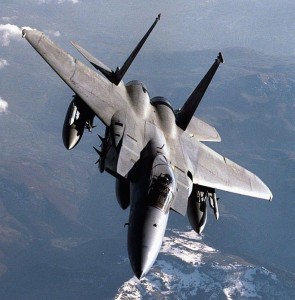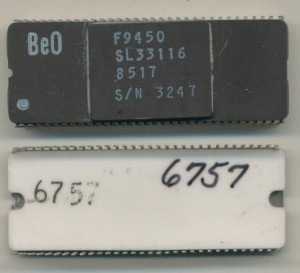CPU of the Day: Fairchild F9450 – Commercial Military
In 1980 the United States Air Force published a standard for a 16-bit Instruction Set Architecture (ISA) to meet their needs for computers on fighters etc. This standard is known as MIL-STD-1750A and laid out what the processor needed to be able to do, but not how, or what would be used to accomplish it. This allowed manufacturers to implement the standard in anyway they wanted. It could be done in CMOS, Bipolar, SoS, GaAs or even ECL. It was designed (like the Signetics 8X300 and the Ferranti F100) with real time processing in mind, similar to what we would call a DSP today.
Many companies made 1750A compatible processors including Honeywell, Performance Semiconductor (now Pyramid), Bendix (Allied), Fairchild, McDonnell Douglas, and others. The processors ended up finding uses in many things outside of the USAF, including many satellites and spacecraft including the Mars Global Surveyor. The standard was not restricted to military use, in fact commercializing it was encouraged, as this would increase production, which would help decrease costs for the military.
 Fairchild designed the F9450 to meet both the commercial, and military markets. Initial availability was in 1985 and the F9450 provides an on-board floating point unit, an optional, second chip, on other implementations. Fairchild also made a F9451 MMU (Memory Management Unit), and a F9452 BPU (Block Protection Unit). The 9450 was manufactured in a bipolar process (Fairchild called it I3L for Isoplanar Integrated Injection Logic). This helped boost speed, as well as greatly increased reliability, as bipolar is much less susceptible to higher radiation levels then CMOS is. Bipolar processes also generate heat, lots of it and to help counter this Fairchild used a somewhat unusual (for a processor) ceramic package made of Beryllium Oxide (BeO). BeO has a higher thermal conductivity than any other non-metal except diamond, and actually exceeds that of some metals. Normally the ceramic on a CPU package is some form of Alumina (Al2O3). Beryllium itself is a carcinogen so grinding, or acid application on BeO is not recommended. The bottom of the the 9450 was made with a different ceramic, as the goal was to get the heat away from the chip, and not back into the PCB. 9450s were available in speeds of 10, 15 and 20MHz and in Commercial, or Military temperature rating. MIL-STD-883 screening was of course available.
Fairchild designed the F9450 to meet both the commercial, and military markets. Initial availability was in 1985 and the F9450 provides an on-board floating point unit, an optional, second chip, on other implementations. Fairchild also made a F9451 MMU (Memory Management Unit), and a F9452 BPU (Block Protection Unit). The 9450 was manufactured in a bipolar process (Fairchild called it I3L for Isoplanar Integrated Injection Logic). This helped boost speed, as well as greatly increased reliability, as bipolar is much less susceptible to higher radiation levels then CMOS is. Bipolar processes also generate heat, lots of it and to help counter this Fairchild used a somewhat unusual (for a processor) ceramic package made of Beryllium Oxide (BeO). BeO has a higher thermal conductivity than any other non-metal except diamond, and actually exceeds that of some metals. Normally the ceramic on a CPU package is some form of Alumina (Al2O3). Beryllium itself is a carcinogen so grinding, or acid application on BeO is not recommended. The bottom of the the 9450 was made with a different ceramic, as the goal was to get the heat away from the chip, and not back into the PCB. 9450s were available in speeds of 10, 15 and 20MHz and in Commercial, or Military temperature rating. MIL-STD-883 screening was of course available.
By 1996 the 1750A architecture was declared inactive and not recommended for new designs. However, due to its extensive software support, reliability, and familiarity, it enjoys continued use, and is still being manufactured by several companies.


